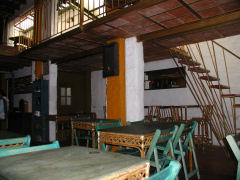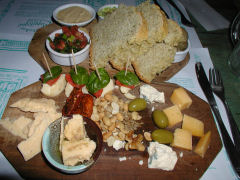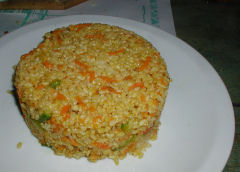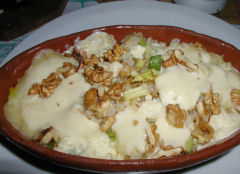Buenos Aires – The first of the month seems like a good time for new announcements. I’ve decided to make Buenos Aires my home base for awhile… i.e., indefinitely. Being in love will do that to you. Really liking a city will do that to you. A great exchange rate sure doesn’t hurt. This has been in the works for a little while, and I actually started looking at apartments roughly two weeks ago. I’ve found one that I like a lot… more on that if my offer goes through.
The first thing I needed to do was start handling the notorious volume of Argentinian government red-tape. Item number one on the list, a C.D.I., or clave de identificacion. Essentially, the Argentine equivalent of a social security number. I was forewarned that this had the potential of being a minor ordeal, but far easier than some of the things I might need in the future. Someone gave me the website link to AFIP, the government office that issues these (along with numerous other things), and I went there, entered my current address, and was given the address of an office at which to show up.
My Spanish teacher and friend Max offered to accompany me, to assist if there were any complicated explanations or difficulties. We arrived at the AFIP office at 1:48 p.m. There were five people in line in front of us. The office was clean, modern, and seemed well staffed. The man behind the information desk was questioning each person as to their needs and then handing them appropriate forms. A moment or two later he looked at his watch and then looked at the line (which had now extended behind me). Musing for a moment, he pointed at me and announced that I was to be the last person as the office was going on strike today from 2:00 until 6:00 (these things are very organized and announced in advance). The people behind me grumbled, but turned around and left.
At the counter I was handed two copies of a form to fill out, which took about three minutes. At the processing desk we were next (and last), and after a moment a young woman called us over. She looked over the forms, had me fill in a few things that weren’t quite correct, asked for a copy of my passport (thankfully I carry one with me) and a copy of my apartment lease (which I’d brought, though not a copy, I’ll have to just live with not having a copy for a couple of weeks). She then punched numbers into her computer, meanwhile glancing occasionally at her watch. Her co-workers gradually filed out until few folk were left. She stabbed at keys a bit faster, waited a moment, and then filled in a number at the top of each copy of the form. A rubber stamp and she handed it back to me. Total time? Maybe fifteen minutes. And she was only 3-4 minutes late for the strike. She probably got overtime for it.
 A couple of weeks ago I was wandering in San Telmo and someone had handed me a flyer for a “vegeterian colonial restaurant.” I’d passed it on to Max, who is vegetarian, and we decided to go check it out and celebrate my new registered status. A short walk took us to Coquitoque, at Balcarce 958, which indeed advertised itself out front as both vegetarian and “colonial food.” Our best guess after looking at the eclectic menu was that anywhere in the world that had ever been a colony of anywhere else was fair game. The place is kind of cute, with simple wooden tables and chairs, a small mezzanine with a skylight, and a sort of caribbean dive feel to it. The menu is in both Spanish and English and includes a short selection of beer and wine.
A couple of weeks ago I was wandering in San Telmo and someone had handed me a flyer for a “vegeterian colonial restaurant.” I’d passed it on to Max, who is vegetarian, and we decided to go check it out and celebrate my new registered status. A short walk took us to Coquitoque, at Balcarce 958, which indeed advertised itself out front as both vegetarian and “colonial food.” Our best guess after looking at the eclectic menu was that anywhere in the world that had ever been a colony of anywhere else was fair game. The place is kind of cute, with simple wooden tables and chairs, a small mezzanine with a skylight, and a sort of caribbean dive feel to it. The menu is in both Spanish and English and includes a short selection of beer and wine.
 We started with their tabla vegetariana, or vegetarian selection. It arrived in a few minutes plated on two wooden boards. One contained a selection of different cheeses – roquefort, parmesan, mozzarella, and a couple of different Sardinian cheeses. It also had a couple of olives, a small heap of nuts, and some crisp fried sun-dried tomatoes (a different approach to serving them, kind of fun, almost like a thick tomato chip). The other board had several slices of thick homemade bread accompanied by pickled eggplants, eggplant purée, hummus, guacamole, and chancho (a Chilean salsa of tomatoes, green onions, and herbs).
We started with their tabla vegetariana, or vegetarian selection. It arrived in a few minutes plated on two wooden boards. One contained a selection of different cheeses – roquefort, parmesan, mozzarella, and a couple of different Sardinian cheeses. It also had a couple of olives, a small heap of nuts, and some crisp fried sun-dried tomatoes (a different approach to serving them, kind of fun, almost like a thick tomato chip). The other board had several slices of thick homemade bread accompanied by pickled eggplants, eggplant purée, hummus, guacamole, and chancho (a Chilean salsa of tomatoes, green onions, and herbs).
 For main courses: arroz hindu, or Hindu rice, described as whole grain rice with a selection of different vegetables and flavored with curry. Max being a major fan of curry decided that he couldn’t pass that one up. I went for a casserole, sabor mediteraneo, or mediterranean flavor, which was described as toasted bulghur wheat with celery and walnuts, topped with cheeses of the mediterranean area. Both were quite good, the curry flavor was a little light (the waiter had asked if Max wanted it spicy,
For main courses: arroz hindu, or Hindu rice, described as whole grain rice with a selection of different vegetables and flavored with curry. Max being a major fan of curry decided that he couldn’t pass that one up. I went for a casserole, sabor mediteraneo, or mediterranean flavor, which was described as toasted bulghur wheat with celery and walnuts, topped with cheeses of the mediterranean area. Both were quite good, the curry flavor was a little light (the waiter had asked if Max wanted it spicy,  perhaps having said no, they limited the curry content of the dish). A couple of glasses of fresh tangerine juice made a great pairing. One side note, this is the first restaurant where I’ve ever been asked what if I wanted my bottled water served cold or room temperature.
perhaps having said no, they limited the curry content of the dish). A couple of glasses of fresh tangerine juice made a great pairing. One side note, this is the first restaurant where I’ve ever been asked what if I wanted my bottled water served cold or room temperature.
We had more than enough food to eat with this and decided against desserts, though they have an interesting sounding selection. We sat for a bit and relaxed, since it had started drizzling outside – it was a nice quiet afternoon.
[Note: this restaurant has closed.]